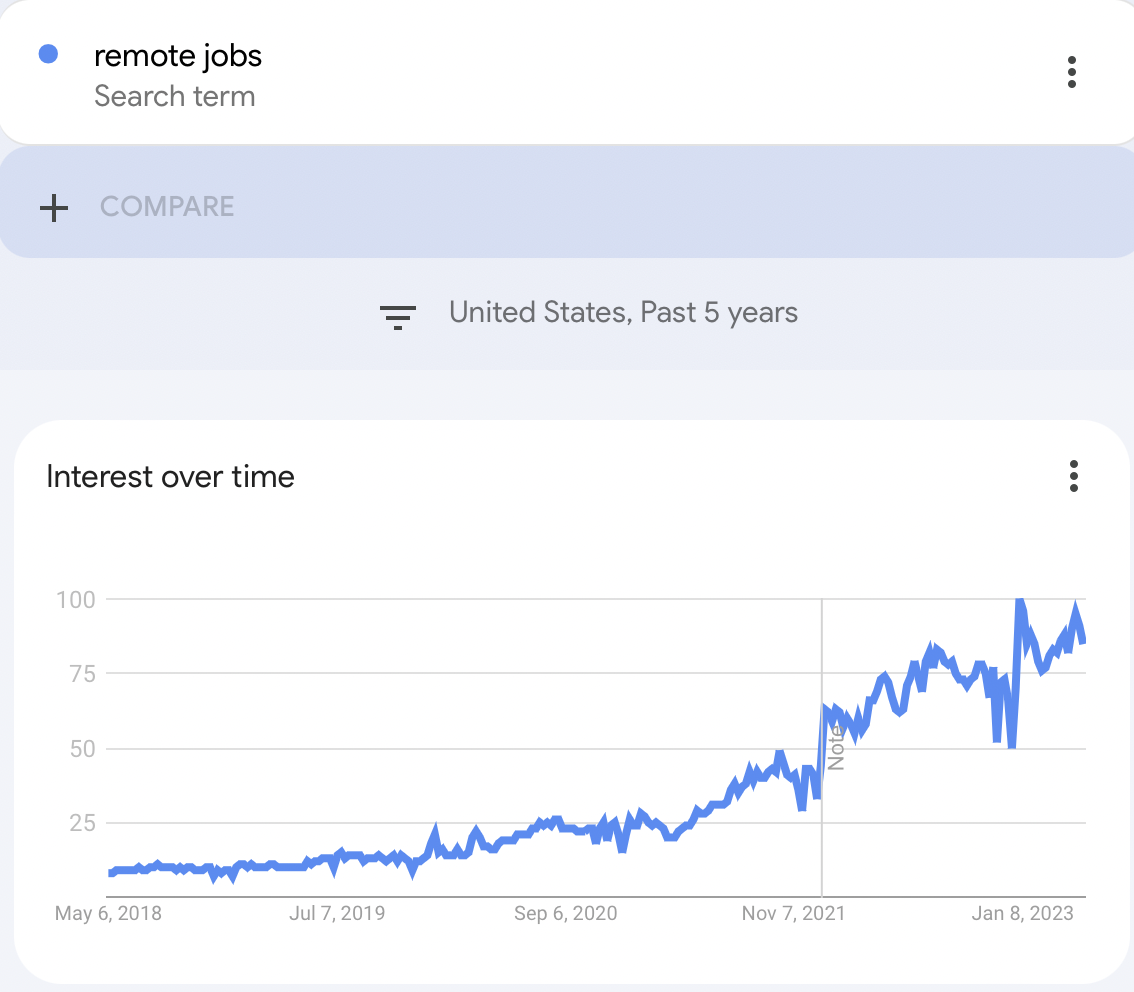Remote work statistics and trends (2023)
- Date
-
 Ryan Bednar
Ryan Bednar
Remote work is a trend that's been steadily growing over time. With COVID-19, that growth has only increased and in 2023 we continue to see significant growth ahead.

Taking a step back: a history of remote work (starting in the 1970’s!)
Remote work, also known as telecommuting or telework, refers to the practice of working outside of a traditional office environment, typically from a home office or a co-working space. While remote work has become increasingly popular in recent years, its history can be traced back several decades.
One of the earliest examples of remote work can be found in the 1970s, when IBM began experimenting with telecommuting as a way to reduce office space and increase productivity. By the 1980s, advances in technology, such as the fax machine and early versions of email, made remote work more feasible for a wider range of workers.
The widespread adoption of the internet in the 1990s and early 2000s further facilitated the growth of remote work. Companies began to offer employees the ability to work from home one or more days per week, while freelance and contract workers embraced the flexibility that remote work offered.
In recent years, the rise of video conferencing software and other collaboration tools has made remote work more accessible and effective than ever before. Today, remote work is a common practice across a wide range of industries, and many companies have fully embraced it as a way to attract and retain top talent, reduce overhead costs, and improve work-life balance for employees.
Remote work grew steadily until COVID-19, and then exploded

The COVID-19 pandemic had a profound impact on remote work, with many companies and employees forced to adapt quickly to a new way of working in order to maintain business operations. With social distancing measures in place and many cities and countries under lockdown, working from home became a necessity for a large number of workers around the world.
Remote work became the new normal for many companies, regardless of their size or industry, as they quickly adapted to a fully virtual work environment. The widespread adoption of video conferencing tools and other remote collaboration technologies allowed employees to stay connected and productive despite physical distance.
The pandemic also had significant implications for the future of work, with many experts predicting that remote work will continue to play a prominent role even after the pandemic is over. Many companies have reported higher levels of productivity and job satisfaction among remote workers, leading them to consider offering more flexible work arrangements even after the pandemic ends.
However, remote work during the pandemic was not without its challenges. Many employees struggled with isolation, work-life balance, and the blurring of boundaries between work and personal life. Employers had to find new ways to support their remote workforce, from providing technology and equipment to offering mental health support.
Many employers want people back in office in 2023
The shift to remote work in 2021 led many to believe that this would become the new normal. However, a survey conducted by the US Department of Labor's Bureau of Labor Statistics (BLS) in August-September 2022 showed that the number of establishments offering remote work had decreased compared to the same period the previous year.
In 2021, 29.8% of companies had some employees working remotely, but this dropped to 16.4% in 2022. Additionally, 72.5% of establishments had little or no telework, up from 60.1% in 2021. The BLS survey found that the information, professional and business services, educational services, and wholesale trade sectors were the most likely to employ remote workers. Conversely, industries like accommodation and food services, natural resources and mining, construction, and retail trade rarely or never employed remote workers.
Many companies have been requiring their employees to work on-site at least partially to promote collaboration and culture. However, the survey found that 95.1% of establishments expected the amount of telework to remain the same in the next six months. Employees' newfound ability to work remotely has provided them with more career flexibility, enabling them to pursue nontraditional work arrangements. Employers that offer remote work and other nontraditional work arrangements may experience better retention rates and increased productivity.
However, such employers need to ensure that their attendance, leave, time-keeping, and data privacy policies support flexible work arrangements. Employers must address and account for long breaks if they have non-exempt employees working remotely. Furthermore, companies must revisit anti-harassment and anti-discrimination policies to account for the transition to video calls, review policies to ensure messaging channels are used in line with company expectations, and consider requests to work from home or in a hybrid arrangement as a reasonable accommodation.
Remote employees don’t want to go back!
An employer that previously allowed remote work over the last three years would have a more difficult time claiming that a worker's request to work remotely or on a hybrid schedule poses an undue hardship. Overall, while remote work has decreased in popularity, the potential benefits for both employees and employers mean that it is here to stay in some capacity.
Hybrid or remote work options are being offered by most companies, allowing employees to work where they desire for at least some portion of their workweek.
However, given the growing number of organizations offering hybrid work, it is essential to evaluate how companies maintain constructive cultures, communicate and lead, as well as foster career growth in remote settings. It is imperative to inquire about these aspects to guarantee a positive experience that enhances both one's career and personal life.
Moreover, the current demand for remote work opportunities is significant, as demonstrated by the surge in Google searches. Searches for "work when you want remote jobs" have risen by 556%, while searches for "what remote jobs are in demand" have increased by 357%. Furthermore, searches for "remote positions" and "remote part-time jobs" have increased by 85% and 105%, respectively, reaching an all-time high.
In conclusion, remote work presents an attractive option for many professionals seeking greater flexibility and autonomy. However, it is crucial to evaluate the organizational culture, leadership, and career development opportunities, as well as prepare for intense competition in the job market.
Most Popular Keywords in Remote Job Searches in June 2021
| Rank | Top Keywords | % of All Remote Job Searches |
|---|---|---|
| 1 | human resources | 1.4% |
| 2 | graphic designer | 0.7% |
| 3 | project manager | 0.7% |
| 4 | software engineer | 0.6% |
| 5 | customer success manager | 0.6% |
| 6 | data entry | 0.5% |
| 7 | marketing | 0.5% |
| 8 | executive assistant | 0.5% |
| 9 | data analyst | 0.5% |
| 10 | customer services representative | 0.4% |
Most Popular Sectors for Remote Job Applications in June 2021
| Rank | Sectors | % of All Remote Job Applicants |
|---|---|---|
| 1 | Information Technology | 24.8% |
| 2 | Business Services | 11.3% |
| 3 | Health Care | 4.5% |
| 4 | Finance | 3.2% |
| 5 | Education | 2.5% |
| 6 | Insurance | 2.2% |
| 7 | Manufacturing | 1.6% |
| 8 | Media | 1.5% |
| 9 | Biotech & Pharmaceuticals | 1.4% |
| 10 | Retail | 1.4% |
